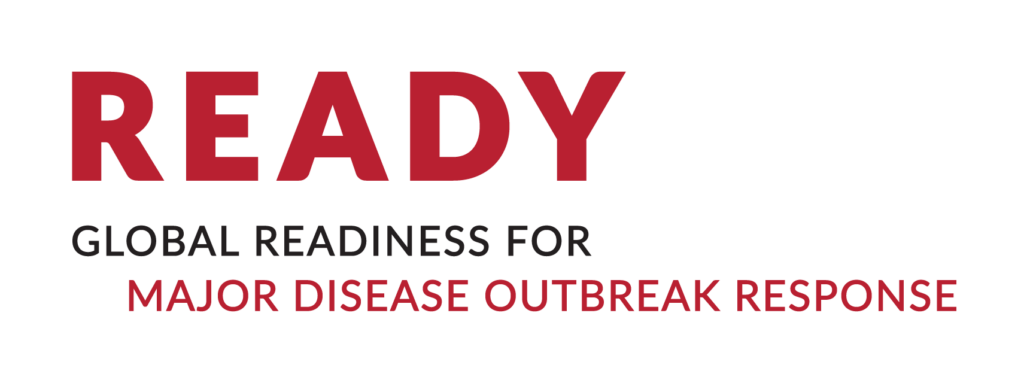Zingatia kutambua mara moja idadi sawa ya viongozi wa jumuiya ya wanaume na wanawake, maeneo muhimu ya jumuiya, na wafanyakazi wa afya ya jamii (CHWs). Wafunze kuhusu COVID-19, ikijumuisha ufafanuzi wa kesi za eneo lako, itifaki za kutogusa, PPE, ujumbe wa mawasiliano ya hatari husika, na mahali pa kurejelea huduma za sekta mbalimbali (za afya, lishe, MHPSS, ulinzi).
Toa mwongozo wa kiufundi ikihitajika kwa MOH ili kuunda istilahi maalum za marejeleo kwa CHWs kuhusu jukumu lao katika kukabiliana na COVID-19.
Kubali hatari asili inayohusiana na hatua za kutengwa na uimarishe au uweke hatua za usalama ili kutambua hatari zinazohusiana na muktadha mahususi. Kuhakikisha kuwa hatua za kutosha zinachukuliwa ili kuanzisha, kuendesha na kufuatilia vituo hivyo.
Chukua tahadhari zinazofaa (na wakati fulani, sitisha au ubadilishe mipango isiyo ya lazima) kwa kazi ya shambani inayohusiana na utafiti usio na COVID-19 kuhusu watu na wanyama ili kulinda afya na usalama wa viumbe vyote.11
Kumbuka kwenye PPE
PPE hutumiwa kila siku na wafanyikazi wa afya kama njia ya kuzuia na kudhibiti maambukizi ili kujilinda na wagonjwa. Katika muktadha wa COVID-19, PPE inajumuisha glavu, barakoa za matibabu, vipumuaji, miwani, ngao za uso na gauni. Kwa kuzingatia uhaba wa jumla wa PPE, WHO inapendekeza kwamba PPE ihifadhiwe kwa wafanyikazi wa afya na matumizi ya barakoa kwa wale ambao wamethibitishwa na COVID-19 ili kupunguza maambukizi.12 Vinyago visivyo vya matibabu au vifuniko vya uso vinapendekezwa kwa umma kwa ujumla.13 Serikali na Mashirika Yasiyo ya Kiserikali huamua usambazaji wa PPE kwa wafanyikazi, wafanyikazi wa afya, wafanyikazi wa mawasiliano, n.k. kulingana na upatikanaji wa PPE katika masoko yao ya ndani. Mwongozo huu unarejelea matumizi ya PPE/vifuniko vya uso, na kukiri kwamba matumizi ya PPE yatatekelezwa kwa njia tofauti kulingana na maagizo ya kitaifa, sera za shirika na upatikanaji wa PPE.
Fikiria kufanya utetezi na serikali za kitaifa na serikali za mitaa ili kuhakikisha kuendelea kwa huduma za afya ya jamii na marekebisho ya haraka ya itifaki za kitaifa ili kuhakikisha utoaji wa huduma salama wa huduma za msingi za afya.
Wahudumu wa afya ya jamii wataendelea kutumika kama kiungo muhimu kwa vituo vya huduma ya afya ya msingi, vituo vya karantini, au CIC na vitengo vya matibabu. Ili kuunga mkono mbinu jumuishi kutoka kwa mtazamo wa mtu aliyeathiriwa, CHWs, viongozi wa jamii na uhusiano, kijamii/wafanya kazi, n.k. hutumika kama wajumbe muhimu na mawakala wa rufaa kwa huduma na matunzo mbalimbali ambayo watu binafsi na kaya walioathirika wanaweza kuhitaji.
Utoaji wa PPE sahihi na akiba ya akiba ya dawa, vifaa, zana
Tambua na ukubaliane kuhusu mbinu mbadala za kutoa utunzaji wa kimatibabu na rufaa, ikijumuisha kuzingatia uboreshaji wa mawasiliano ya simu kwa vituo na wafanyikazi wote wa kijamii.
Jitayarishe na viongozi wa jamii kwa matukio ya umbali wa kimwili. Chagua redio inayopatikana, rununu, mitandao ya kijamii, au chaneli zingine za ushiriki wa mbali (kwa mfano, kukusanya nambari za simu, anzisha vikundi vya WhatsApp, kuwafahamisha wanajamii jinsi ya kuunganishwa kidijitali na maonyesho ya jumuiya halisi).
READY inatoa mwongozo juu ya a mchakato wa hatua sita wa ushiriki wakati wa COVID-19 ambayo inaweza kuunganishwa na mwongozo ufuatao juu ya Suluhisha Kuokoa Maisha' Anwani Tracing Playbook.
CHWs, wafanyakazi wa kijamii, na wafanyakazi wengine wa kufikia jamii wanapaswa kupokea fursa ya kukataa kuunga mkono jibu au kujadiliana kuhusu majukumu tofauti mwanzoni au wakati wowote wa jibu iwapo wataona kuhusika kwao ni hatari sana, ama kwao wenyewe au kwa wengine.
11 Miongozo ya Kufanya kazi na Mamalia wa Pori Wanaoishi Bila Malipo katika ERA ya Janga la COVID-19. 2020. Shirika la Dunia la Afya ya Wanyama; 2020. (https://www.oie.int/fileadmin/Home/eng/Our_scientific_expertise/docs/pdf/COV-19/WHSG_and_OIE_COVID-19_Guidelines_Aug2020.pdf ilifikiwa Septemba 9, 2020)
12 Matumizi ya busara ya vifaa vya kinga ya kibinafsi kwa ugonjwa wa coronavirus (COVID-19) na mambo yanayozingatiwa wakati wa uhaba mkubwa. 2020. Geneva: Shirika la Afya Duniani; 2020. (https://www.who.int/publications/i/item/rational-use-of-personal-protective-equipment-for-coronavirus-disease-(covid-19)-and-considerations-during-severe-shortages ilifikiwa Agosti 26 2020)
13 Ushauri kuhusu matumizi ya barakoa katika muktadha wa COVID-19. 2020. Geneva: Shirika la Afya Duniani; 2020.(https://www.who.int/publications/i/item/advice-on-the-use-of-masks-in-the-community-during-home-care-and-in-healthcare-settings-in-the-context-of-the-novel-coronavirus-(2019-ncov)-outbreak ilifikiwa Agosti 26 2020)

